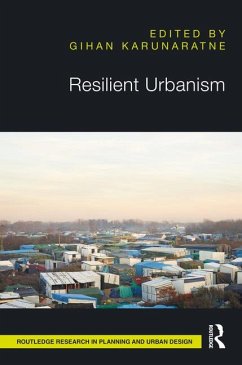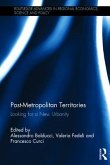Resilient Urbanism
Herausgeber: Karunaratne, Gihan
Resilient Urbanism
Herausgeber: Karunaratne, Gihan
- Gebundenes Buch
- Merkliste
- Auf die Merkliste
- Bewerten Bewerten
- Teilen
- Produkt teilen
- Produkterinnerung
- Produkterinnerung
As urban populations grow unprecedentedly, cities worldwide face pressures from rapid expansion, climate change, and social inequalities. Resilient Urbanism critically examines how cities, towns, and informal settlements adapt to these multifaceted challenges, exploring urban resilience in the 21st century.
Andere Kunden interessierten sich auch für
![Architecture, Landscape, and Design in Post-Mining Territories Architecture, Landscape, and Design in Post-Mining Territories]() Architecture, Landscape, and Design in Post-Mining Territories186,99 €
Architecture, Landscape, and Design in Post-Mining Territories186,99 €![Entrepreneurship, Innovation and Smart Cities Entrepreneurship, Innovation and Smart Cities]() Vanessa RattenEntrepreneurship, Innovation and Smart Cities178,99 €
Vanessa RattenEntrepreneurship, Innovation and Smart Cities178,99 €![Ethics and Planning Research Ethics and Planning Research]() Francesco Lo PiccoloEthics and Planning Research188,99 €
Francesco Lo PiccoloEthics and Planning Research188,99 €![Post-Metropolitan Territories Post-Metropolitan Territories]() Post-Metropolitan Territories205,99 €
Post-Metropolitan Territories205,99 €![Debt Debt]() David GraeberDebt17,99 €
David GraeberDebt17,99 €![The Right to Be Lazy The Right to Be Lazy]() Paul LafargueThe Right to Be Lazy30,99 €
Paul LafargueThe Right to Be Lazy30,99 €![Expanding the Economic Concept of Exchange Expanding the Economic Concept of Exchange]() Expanding the Economic Concept of Exchange115,99 €
Expanding the Economic Concept of Exchange115,99 €-
-
-
As urban populations grow unprecedentedly, cities worldwide face pressures from rapid expansion, climate change, and social inequalities. Resilient Urbanism critically examines how cities, towns, and informal settlements adapt to these multifaceted challenges, exploring urban resilience in the 21st century.
Produktdetails
- Produktdetails
- Verlag: Taylor & Francis
- Seitenzahl: 276
- Erscheinungstermin: 8. Mai 2025
- Englisch
- Abmessung: 234mm x 156mm
- Gewicht: 640g
- ISBN-13: 9781032748320
- ISBN-10: 103274832X
- Artikelnr.: 72598477
- Herstellerkennzeichnung
- Libri GmbH
- Europaallee 1
- 36244 Bad Hersfeld
- gpsr@libri.de
- Verlag: Taylor & Francis
- Seitenzahl: 276
- Erscheinungstermin: 8. Mai 2025
- Englisch
- Abmessung: 234mm x 156mm
- Gewicht: 640g
- ISBN-13: 9781032748320
- ISBN-10: 103274832X
- Artikelnr.: 72598477
- Herstellerkennzeichnung
- Libri GmbH
- Europaallee 1
- 36244 Bad Hersfeld
- gpsr@libri.de
Gihan Karunaratne is an architect and academic. He has a notable record of teaching and lecturing in Architecture, Urban Design, and Interior Design across various international settings. His academic contributions are characterized by substantial research and scholarly publications addressing critical architecture and urban design topics. Karunaratne's current research, which is deeply interdisciplinary, centers on the shifting dynamics of architecture and urban environments, particularly in cities undergoing continuous physical, economic, and social transformations. His work critically engages with the complexities of urban change, with a specific focus on marginalized and non¿conformist communities. A distinctive feature of his research is the exploration of the "underbelly" of cities, offering a detailed analysis of informal settlements and their social, economic, and spatial conditions. His engagement with urban transitions, particularly within the Global South, underscores his scholarly focus on the challenges and potential of informal urban environments. Karunaratne's work contributes to the ongoing academic discourse on urban transformation, spatial justice, and the lived experiences of underserved communities, demonstrating the breadth and depth of his research.
List of figures
List of tables
List of contributors
Introduction
Gihan Karunaratne
Section 1: Urban Resilience
Chapter 1: Nocturnal Urbanism: The Case of Kimbulawala Food Street
Gihan Karunaratne, Wasana G.K. Withana, Jagath Munasinghe and Tanzil
Shafique
Chapter 2: Modern Vernacular: Informal Housing Architecture and Urban
Resilience
Johan Mottelson
Chapter 3: From Disparity to Sustainability: The Journey of Energy
Efficiency in Buenos Aires' Low-Income Neighborhoods
Cynthia Goytia and Gaston Gertner
Chapter 4: Urban Resilience and General Crisis: Theory, Practice and
Politics.
Kanishka Goonewardena
Section 2: Re-imagining practices of resilience
Chapter 5: Speculative drawing as a tool for urban resilience
Angeliki Sakellariou
Chapter 6: Measuring resilience: Leveraging Computational Methods and GIS
Data for AI Decision-Making Tools
Luigi Pintacuda and Silvio Carta
Chapter 7: The Importance of Regional Food Security in Achieving Supply
Chain Resilience: A Case Study
Ali Cheshmehzang and Tong Zou
Section 3: Housing and Urbanism
Chapter 8: A new role for Remizas: fostering resilience for a just
transition
Julia Wlodarczyk and Maximilian Sternberg
Chapter 9: Water supply systems in urban slum communities in Lagos,
Nigeria: between self-supply and co-production.
Fabienne Hoelzel
Chapter 10: City matters
Matthew Rosen and Marie Stargala
Section 4: Community and Social Resilience
Chapter 11: Resilience at the Seams: A Case Study on Makeshift Cattle
Markets in Dhaka, Bangladesh
Nusrat Jahan Mim
Chapter 12: Governance, power, and agency in a period of uncertainty
Peter Bishop
Chapter 13: Performative AND Representational Infrastructure: Its Role in
Community Engagement and Empowerment for Resilience
Alan J. Plattus and Andrei Harwell
Section 5: Climate Urbanism
Chapter 14: More than a Roof and Four Walls: Exploring Principles, process,
and possibilities for climate justice and resilience through housing and
land rights in Cartagena and beyond Johanna Lovecchio, Maristella Madero,
Juliet Tochterman and Kaitlynn Zack
Chapter 15: Place-based scenario planning: a design research methodology
for climate adaptation.
Kira Clingen
List of tables
List of contributors
Introduction
Gihan Karunaratne
Section 1: Urban Resilience
Chapter 1: Nocturnal Urbanism: The Case of Kimbulawala Food Street
Gihan Karunaratne, Wasana G.K. Withana, Jagath Munasinghe and Tanzil
Shafique
Chapter 2: Modern Vernacular: Informal Housing Architecture and Urban
Resilience
Johan Mottelson
Chapter 3: From Disparity to Sustainability: The Journey of Energy
Efficiency in Buenos Aires' Low-Income Neighborhoods
Cynthia Goytia and Gaston Gertner
Chapter 4: Urban Resilience and General Crisis: Theory, Practice and
Politics.
Kanishka Goonewardena
Section 2: Re-imagining practices of resilience
Chapter 5: Speculative drawing as a tool for urban resilience
Angeliki Sakellariou
Chapter 6: Measuring resilience: Leveraging Computational Methods and GIS
Data for AI Decision-Making Tools
Luigi Pintacuda and Silvio Carta
Chapter 7: The Importance of Regional Food Security in Achieving Supply
Chain Resilience: A Case Study
Ali Cheshmehzang and Tong Zou
Section 3: Housing and Urbanism
Chapter 8: A new role for Remizas: fostering resilience for a just
transition
Julia Wlodarczyk and Maximilian Sternberg
Chapter 9: Water supply systems in urban slum communities in Lagos,
Nigeria: between self-supply and co-production.
Fabienne Hoelzel
Chapter 10: City matters
Matthew Rosen and Marie Stargala
Section 4: Community and Social Resilience
Chapter 11: Resilience at the Seams: A Case Study on Makeshift Cattle
Markets in Dhaka, Bangladesh
Nusrat Jahan Mim
Chapter 12: Governance, power, and agency in a period of uncertainty
Peter Bishop
Chapter 13: Performative AND Representational Infrastructure: Its Role in
Community Engagement and Empowerment for Resilience
Alan J. Plattus and Andrei Harwell
Section 5: Climate Urbanism
Chapter 14: More than a Roof and Four Walls: Exploring Principles, process,
and possibilities for climate justice and resilience through housing and
land rights in Cartagena and beyond Johanna Lovecchio, Maristella Madero,
Juliet Tochterman and Kaitlynn Zack
Chapter 15: Place-based scenario planning: a design research methodology
for climate adaptation.
Kira Clingen
List of figures
List of tables
List of contributors
Introduction
Gihan Karunaratne
Section 1: Urban Resilience
Chapter 1: Nocturnal Urbanism: The Case of Kimbulawala Food Street
Gihan Karunaratne, Wasana G.K. Withana, Jagath Munasinghe and Tanzil
Shafique
Chapter 2: Modern Vernacular: Informal Housing Architecture and Urban
Resilience
Johan Mottelson
Chapter 3: From Disparity to Sustainability: The Journey of Energy
Efficiency in Buenos Aires' Low-Income Neighborhoods
Cynthia Goytia and Gaston Gertner
Chapter 4: Urban Resilience and General Crisis: Theory, Practice and
Politics.
Kanishka Goonewardena
Section 2: Re-imagining practices of resilience
Chapter 5: Speculative drawing as a tool for urban resilience
Angeliki Sakellariou
Chapter 6: Measuring resilience: Leveraging Computational Methods and GIS
Data for AI Decision-Making Tools
Luigi Pintacuda and Silvio Carta
Chapter 7: The Importance of Regional Food Security in Achieving Supply
Chain Resilience: A Case Study
Ali Cheshmehzang and Tong Zou
Section 3: Housing and Urbanism
Chapter 8: A new role for Remizas: fostering resilience for a just
transition
Julia Wlodarczyk and Maximilian Sternberg
Chapter 9: Water supply systems in urban slum communities in Lagos,
Nigeria: between self-supply and co-production.
Fabienne Hoelzel
Chapter 10: City matters
Matthew Rosen and Marie Stargala
Section 4: Community and Social Resilience
Chapter 11: Resilience at the Seams: A Case Study on Makeshift Cattle
Markets in Dhaka, Bangladesh
Nusrat Jahan Mim
Chapter 12: Governance, power, and agency in a period of uncertainty
Peter Bishop
Chapter 13: Performative AND Representational Infrastructure: Its Role in
Community Engagement and Empowerment for Resilience
Alan J. Plattus and Andrei Harwell
Section 5: Climate Urbanism
Chapter 14: More than a Roof and Four Walls: Exploring Principles, process,
and possibilities for climate justice and resilience through housing and
land rights in Cartagena and beyond Johanna Lovecchio, Maristella Madero,
Juliet Tochterman and Kaitlynn Zack
Chapter 15: Place-based scenario planning: a design research methodology
for climate adaptation.
Kira Clingen
List of tables
List of contributors
Introduction
Gihan Karunaratne
Section 1: Urban Resilience
Chapter 1: Nocturnal Urbanism: The Case of Kimbulawala Food Street
Gihan Karunaratne, Wasana G.K. Withana, Jagath Munasinghe and Tanzil
Shafique
Chapter 2: Modern Vernacular: Informal Housing Architecture and Urban
Resilience
Johan Mottelson
Chapter 3: From Disparity to Sustainability: The Journey of Energy
Efficiency in Buenos Aires' Low-Income Neighborhoods
Cynthia Goytia and Gaston Gertner
Chapter 4: Urban Resilience and General Crisis: Theory, Practice and
Politics.
Kanishka Goonewardena
Section 2: Re-imagining practices of resilience
Chapter 5: Speculative drawing as a tool for urban resilience
Angeliki Sakellariou
Chapter 6: Measuring resilience: Leveraging Computational Methods and GIS
Data for AI Decision-Making Tools
Luigi Pintacuda and Silvio Carta
Chapter 7: The Importance of Regional Food Security in Achieving Supply
Chain Resilience: A Case Study
Ali Cheshmehzang and Tong Zou
Section 3: Housing and Urbanism
Chapter 8: A new role for Remizas: fostering resilience for a just
transition
Julia Wlodarczyk and Maximilian Sternberg
Chapter 9: Water supply systems in urban slum communities in Lagos,
Nigeria: between self-supply and co-production.
Fabienne Hoelzel
Chapter 10: City matters
Matthew Rosen and Marie Stargala
Section 4: Community and Social Resilience
Chapter 11: Resilience at the Seams: A Case Study on Makeshift Cattle
Markets in Dhaka, Bangladesh
Nusrat Jahan Mim
Chapter 12: Governance, power, and agency in a period of uncertainty
Peter Bishop
Chapter 13: Performative AND Representational Infrastructure: Its Role in
Community Engagement and Empowerment for Resilience
Alan J. Plattus and Andrei Harwell
Section 5: Climate Urbanism
Chapter 14: More than a Roof and Four Walls: Exploring Principles, process,
and possibilities for climate justice and resilience through housing and
land rights in Cartagena and beyond Johanna Lovecchio, Maristella Madero,
Juliet Tochterman and Kaitlynn Zack
Chapter 15: Place-based scenario planning: a design research methodology
for climate adaptation.
Kira Clingen








